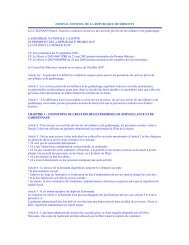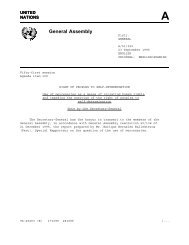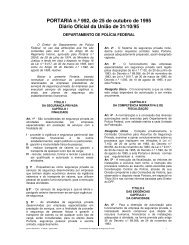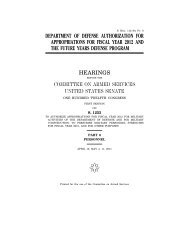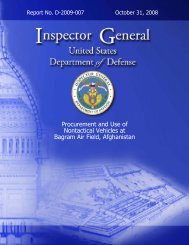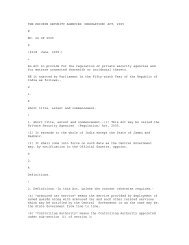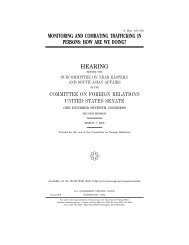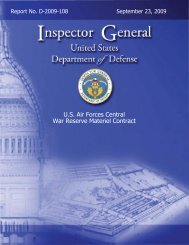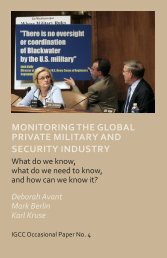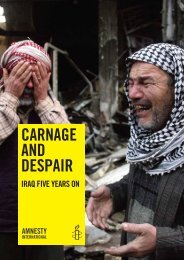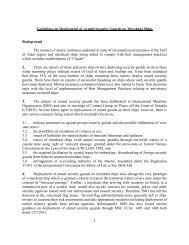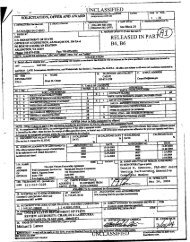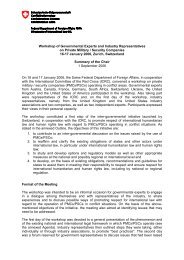Security Assistance; and Logistics - Federation of American Scientists
Security Assistance; and Logistics - Federation of American Scientists
Security Assistance; and Logistics - Federation of American Scientists
Create successful ePaper yourself
Turn your PDF publications into a flip-book with our unique Google optimized e-Paper software.
The Iraqi Government has progressively increased its fiscal commitment to building itssecurity forces <strong>and</strong> developing MoD <strong>and</strong> MoI institutional capacity. In 2006, GoI outlaysfor ISF exceeded that <strong>of</strong> the U.S. government for the first time. The GoI approved a $9.0billion budget for the security ministries for CY 2008. The Iraqi security ministries’budget projection for 2009 was expected to approach $11 billion.Iraq <strong>Security</strong> Forces Fund Funding LeverageFiscal resources – <strong>of</strong> both the United States <strong>and</strong> GoI – have been the principal means atthe disposal <strong>of</strong> MNSTC-I to influence ISF force generation <strong>and</strong> force development, toinclude enabling capabilities such as logistics sustainment. For this reason, the MNSTC-Icenter <strong>of</strong> gravity has been the availability <strong>and</strong> effective application <strong>of</strong> U.S. <strong>and</strong> increasingGoI resources in a timely manner to produce the necessary Iraqi security force <strong>and</strong>defense capability.In addition to providing funds for manning, training, <strong>and</strong> equipping ISF forces for thecounterinsurgency effort, ISFF funds have been used principally in accelerating thegeneration <strong>and</strong> fielding <strong>of</strong> new forces. The availability <strong>of</strong> ISFF funds <strong>and</strong> the flexibilitywith which they could be directed at specific projects have made ISFF particularlyvaluable to MNSTC-I in achieving force generation objectives.As ISFF availability has diminished <strong>and</strong> more restrictions have been placed on theirapplication, MNSTC-I has had to reprioritize their use, in many cases leveragingavailable ISFF funds as “seed money” for larger ISF projects with the expectation <strong>of</strong> IraqiMoD or MoI buy-in. In this they have had some success. Examples <strong>of</strong> cost sharingactivities have included:• MoDo Fielding MI-17 helicopters <strong>and</strong> Huey IIso Fielding HMMWVs <strong>and</strong> parts supporto Fielding M16/M4so Infrastructure repairs at Taji for National Depot Complex, Regional TrainingCenter, the Iraqi Army Support <strong>and</strong> Service Institute• MoIo Individual police equipmento Training Centers <strong>and</strong> academieso Vehicleso Baghdad Police College ExpansionFinally, the judicious application <strong>of</strong> scarce ISFF funds has the potential for an increasedreturn on U.S. investment. This is particularly important when the funds are used topurchase counter-insurgency equipment that meet U.S. strategic interests in the region<strong>and</strong> which will require additional Iraqi capital investment <strong>and</strong>/or follow-on sustainmentexpenditures.As an example, the U.S. will make a capital outlay <strong>of</strong> approximately $276 million torefurbish <strong>and</strong> field over 8500 HMMWVs for the Iraqi MoD <strong>and</strong> MoI. The GoI willspend $358 million over the next 5 years in sustainment costs for U.S. parts <strong>and</strong>77



